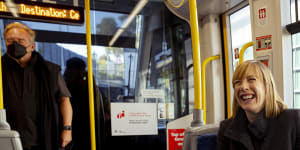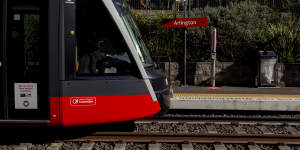Four new Spanish-built trams for the 12.8-kilometre light rail line between Central and Dulwich Hill have been handed over to the state government,bolstering the size of the inner west fleet to 16 vehicles.

NSW Transport Minister Jo Haylen rides on an inner west tram.Dominic Lorrimer
The new trams were purchased for and will progressively enter service over the coming months once testing is completed.
The latest increase in services from Monday will result in trams running every 10 minutes along the L1 Dulwich Hill line between 10am and 3pm on weekdays,up from every 15 minutes.
They will also now run every 10 minutes – from 15-minute intervals – between 9am and 11am on weekends. That frequency of service will continue until 9pm on Saturdays and 7pm on Sundays.
It will result in almost 40 per cent more services during inter-peak periods on weekdays,and 8 per cent more trips a week overall on the inner west line.

Services on the inner west light rail line will increase by about 100 a week.Dominic Lorrimer
NSW Transport Minister Jo Haylen said patronage on the light rail line had bounced back quicker than on Sydney’s trains,particularly on weekends. “These additional 100 new services will really help,” she said.
Haylen,the MP for Summer Hill in the inner west,said the government wanted to increase service frequency further on weekdays and weekends and was “looking at options to do that”.
“We’re always looking at ways to improve public transport and in particular,we know that frequency of service is a big driver in patronage,” she said.
“If you don’t have to wait as long on the platform,you’re more likely to choose public transport.”
Services on the inner west line were halted for months after in the existing fleet of trams in late 2021. The government is yet to resolve a long-running contractual dispute with Spanish manufacturer CAF over the cracks in the trams,which have since been fixed and returned to service.
Mathew Hounsell,a researcher at the University of Technology’s transport research centre,said the major disruption to services caused by the cracked trams had dampened demand in the immediate aftermath.
However,he said patronage had picked up substantially in the past few months and the inner west light rail was “still very popular” with people on weekends.
“Every day of the week it moves over 20,000 people,” he said. “The big driver of demand for the inner west light rail is good frequency. If you know your waiting time will be shorter,you will catch it. The extra vehicles will allow the operator to run more reliable services,and that will attract passengers.”
Last December,weekday peak services on the line were increased to an eight-minute frequency.
Lewisham resident Mary Osborn,a regular user of the light rail,said she had witnessed a significant increase in people catching trams since the depths of the pandemic two years ago. “It is so much nicer than the trains – it is just more airy,” she said.
The Morning Edition newsletter is our guide to the day’s most important and interesting stories,analysis and insights..